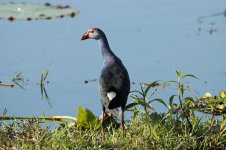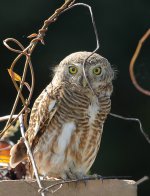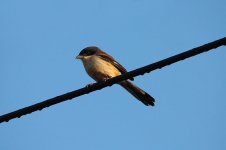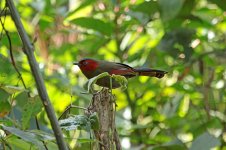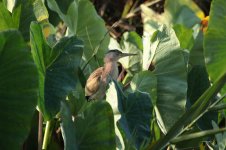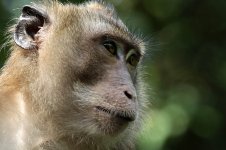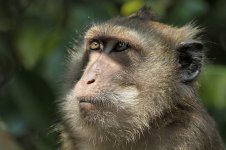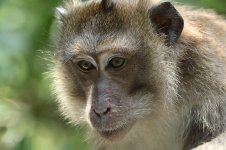
Chiang Saen. 25 December.
Christmas Day, northern Thailand. Not a full day's birding, largely due to wasting an hour or so after locking the keys in the car and another couple visiting Chiang Rai city, but nevertheless with a change of location some good stuff seen.
In the so-called 'Golden Triangle', the temples and markets of Chiang Saen sit right on the junction of three countries, the mighty Mekong River all that separates you from Laos just opposite and Myanmar a few hundred metres upriver. Sipping coffee in a riverside cafe, scope against the table and Green Bee-eaters hawking adjacent, the goal here was to find was to find River Lapwing, a localised species that favours the sand banks in this area. Plain Martins zipped the river, a Temminck's Stint and Little Ringed Plover trotted the edges of mid-channel islands, a Grey Heron lumbered down the river. No immediate sign of the River Lapwing, but a short stroll soon changed that ...a rather smart pair found on a small side channel a half kilometre downchannel. A bonus indeed, one Yellow-legged Buttonquail also seen here, an individual running out from trackside scrub on the river embankment!
Next came the very clever move of locking the car keys in the boot! Duh! Waited for an hour while various locksmiths were apparently 'on the way', then got news that actually no locksmith could be found! Hmpph! Smashed a small side window and opened the car ...we were mobile again, albeit with a new ventilation system!
Needing to go to Chiang Rai, there was still time to pop into Chiang Saen Lake on the way - vast beds of water lily and gentle bays, large flocks of Lesser Whistling Ducks and gaggles of Purple Swamphen, it was certainly a picturesque spot. Sitting in the shadow of Wat Phrathatsiwiangkan temple, we only had an hour here, but most relaxing it was, Purple Herons winging over, Spot-billed Ducks and flocks of Coots drifting by, one Eastern Marsh Harrier flushing the lot. Also Mallard here, my only sighting in Thailand. Unfortunately soon I had to go, town was calling, the birding over.
So was that it for Christmas Day? No real birding treat? Na, absolutely not, the real treat was still to come! After a short stop in Chiang Rai, I was back at Chiang Saen Lake, this time at Wat Bamakno on the opposite side. It was now an hour or so before sunset and one of the true ornithological spectacles of Thailand was about to unfold!
Gazing across the adjacent marsh, great pods of Purple Swamphens clambered through the rank vegetation, Little Egrets picked their way through shallows, the first drifts of Barn Swallows came hawking in, later many would congregate to roost. Scanning either way, no hints in the skies of the birds that would soon come pouring in. Three Chestnut-tailed Starlings flew over, Oriental Magpie Robins scuttled from neighbouring bush, the sun began to edge towards the horizon. Then, almost simultaneously, in straggling waves from both the north and south, they began to arrive, first a few singles, then pairs and small flocks, then a mass of them, settling on the marsh directly in front, rising and chasing a little, little clouds of them circling in the growing twilight. Absolutely spectacular, the birds were harriers - hundreds and hundreds, Pied Harriers and Eastern Marsh Harriers everywhere. What a glorious sight, by dark there were perhaps 700 of these beauties littering the ground in front, the two species intermingling, stunning male Pied Harriers all lined out, interspersed by the others. It was very difficult to get any accurate counts, as birds were streaming in right to dark and a second group were landing a little to the north, but it certainly seemed that the Pied Harriers were the most numerous in the roost. Either way, it was a stunning spectacle, a nice way to end Christmas Day! For added effect, a flock of about 250 Red-throated Pipits also dropped in to roost!
Christmas Day, northern Thailand. Not a full day's birding, largely due to wasting an hour or so after locking the keys in the car and another couple visiting Chiang Rai city, but nevertheless with a change of location some good stuff seen.
In the so-called 'Golden Triangle', the temples and markets of Chiang Saen sit right on the junction of three countries, the mighty Mekong River all that separates you from Laos just opposite and Myanmar a few hundred metres upriver. Sipping coffee in a riverside cafe, scope against the table and Green Bee-eaters hawking adjacent, the goal here was to find was to find River Lapwing, a localised species that favours the sand banks in this area. Plain Martins zipped the river, a Temminck's Stint and Little Ringed Plover trotted the edges of mid-channel islands, a Grey Heron lumbered down the river. No immediate sign of the River Lapwing, but a short stroll soon changed that ...a rather smart pair found on a small side channel a half kilometre downchannel. A bonus indeed, one Yellow-legged Buttonquail also seen here, an individual running out from trackside scrub on the river embankment!
Next came the very clever move of locking the car keys in the boot! Duh! Waited for an hour while various locksmiths were apparently 'on the way', then got news that actually no locksmith could be found! Hmpph! Smashed a small side window and opened the car ...we were mobile again, albeit with a new ventilation system!
Needing to go to Chiang Rai, there was still time to pop into Chiang Saen Lake on the way - vast beds of water lily and gentle bays, large flocks of Lesser Whistling Ducks and gaggles of Purple Swamphen, it was certainly a picturesque spot. Sitting in the shadow of Wat Phrathatsiwiangkan temple, we only had an hour here, but most relaxing it was, Purple Herons winging over, Spot-billed Ducks and flocks of Coots drifting by, one Eastern Marsh Harrier flushing the lot. Also Mallard here, my only sighting in Thailand. Unfortunately soon I had to go, town was calling, the birding over.
So was that it for Christmas Day? No real birding treat? Na, absolutely not, the real treat was still to come! After a short stop in Chiang Rai, I was back at Chiang Saen Lake, this time at Wat Bamakno on the opposite side. It was now an hour or so before sunset and one of the true ornithological spectacles of Thailand was about to unfold!
Gazing across the adjacent marsh, great pods of Purple Swamphens clambered through the rank vegetation, Little Egrets picked their way through shallows, the first drifts of Barn Swallows came hawking in, later many would congregate to roost. Scanning either way, no hints in the skies of the birds that would soon come pouring in. Three Chestnut-tailed Starlings flew over, Oriental Magpie Robins scuttled from neighbouring bush, the sun began to edge towards the horizon. Then, almost simultaneously, in straggling waves from both the north and south, they began to arrive, first a few singles, then pairs and small flocks, then a mass of them, settling on the marsh directly in front, rising and chasing a little, little clouds of them circling in the growing twilight. Absolutely spectacular, the birds were harriers - hundreds and hundreds, Pied Harriers and Eastern Marsh Harriers everywhere. What a glorious sight, by dark there were perhaps 700 of these beauties littering the ground in front, the two species intermingling, stunning male Pied Harriers all lined out, interspersed by the others. It was very difficult to get any accurate counts, as birds were streaming in right to dark and a second group were landing a little to the north, but it certainly seemed that the Pied Harriers were the most numerous in the roost. Either way, it was a stunning spectacle, a nice way to end Christmas Day! For added effect, a flock of about 250 Red-throated Pipits also dropped in to roost!





